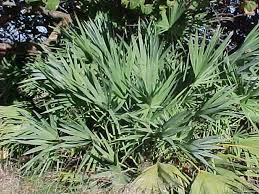http://www.sidhhaherbs.blogspot.com
Serenoa repens
saw palmetto plant

Symptoms of an enlarged prostate include dribbling after urination and getting up many times during the night to urinate.
SAW PALMETTO
A very small type of fan palm, protected in the wild, now famous for extracts from its fruits which are used in treatments of prostate and urinary problems.
Description:
A very slow growing and very short palm, growing to 10-12ft, but often not exceeding 2-4ft. Part of the fan palm group, it has fan-shaped leaves composed of up to 20 leaflets. The common saw palmetto has green leaves but there are some silvery-green leaved types as well. Saw Palmetto's are also long-lived with many wild specimens believed to be well over 500 years old.
Serenoa repens.
 commonly known as saw palmetto, is the sole species currently classified in the genus Serenoa. It has been known by a number of synonyms, including Sabal serrulatum, under which name it still often appears in alternative medicine. It is a small palm, normally reaching a height of around 2–4 m (3–6 ft). Its trunk is sprawling, and it grows in clumps or dense thickets in sandy coastal lands or as undergrowth in pine woods or hardwood hammocks. Erect stems or trunks are rarely produced but are found in some populations. It is endemic to the southeastern United States, most commonly along the Atlantic and Gulf Coastal plains, but also as far inland as southern Arkansas. It is a hearty plant; extremely slow growing, and long lived, with some plants, especially in Florida where it is known as simply the palmetto, possibly being as old as 500–700 years.]
commonly known as saw palmetto, is the sole species currently classified in the genus Serenoa. It has been known by a number of synonyms, including Sabal serrulatum, under which name it still often appears in alternative medicine. It is a small palm, normally reaching a height of around 2–4 m (3–6 ft). Its trunk is sprawling, and it grows in clumps or dense thickets in sandy coastal lands or as undergrowth in pine woods or hardwood hammocks. Erect stems or trunks are rarely produced but are found in some populations. It is endemic to the southeastern United States, most commonly along the Atlantic and Gulf Coastal plains, but also as far inland as southern Arkansas. It is a hearty plant; extremely slow growing, and long lived, with some plants, especially in Florida where it is known as simply the palmetto, possibly being as old as 500–700 years.]
The generic name honors American botanist Sereno Watson.
GERMINATION
By seeds, which should be soaked in warm water for 24 hours prior to planting. Seeds germinate slowly and may take several weeks or months to sprout.
Herbs contain many powerful antioxidants that act to clear
free radicals and toxins from the body.
Historically, saw palmetto has been used as a tea to treat
benign enlargement of the prostate. It was commonly used to treat frequent
urinary tract infections and it was also believed it could increase sex drive
in men and sperm production. Frequent urination and excessive night urination,
due to inflammation of the bladder or prostate, was a common condition treated
by saw palmetto in the past.
This Medicinal Plant helps :
To help build and strengthen tissue and increase metabolism.
As a diuretic which improves urinary flow.
As an expectorant to relieve chronic bronchitis, asthma and
chest congestion.
In thyroid disorders.
To stimulate appetite, digestion and absorption of
nutrients.
physicianpackiam (87)
http://www.sidhhaherbs.blogspot.com
Comments